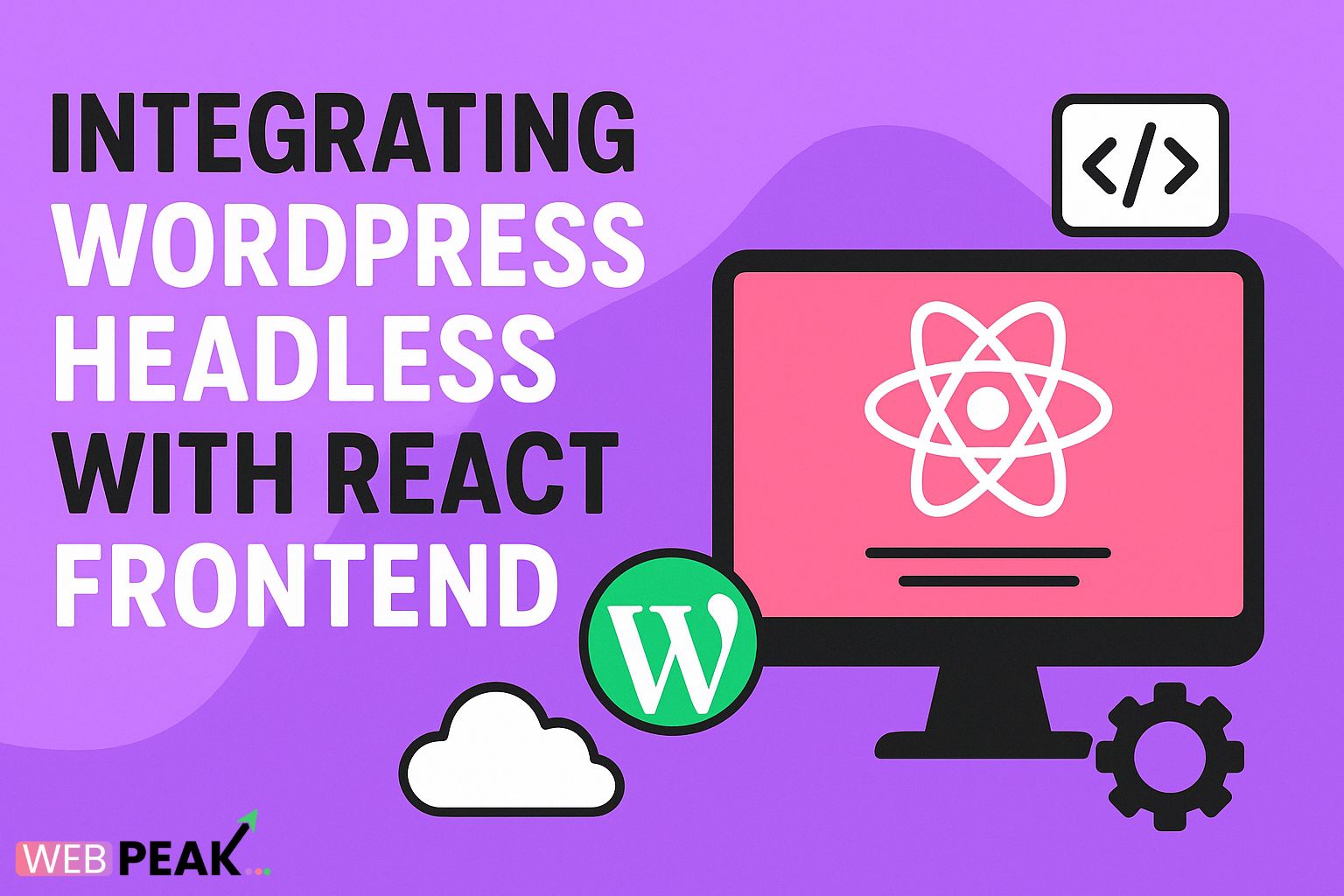Integrating WordPress Headless with React Frontend
Integrating WordPress Headless with React Frontend has become a popular choice for developers and digital marketers aiming to combine the flexibility of WordPress with the performance and modern UX capabilities of React. By decoupling the backend (WordPress) from the frontend (React), you gain more control over speed, interactivity, and scalability. This guide explores the full process of integrating WordPress as a headless CMS with a React-based frontend, including actionable SEO checklist points to ensure maximum visibility and performance.
What Is Headless WordPress?
A Headless WordPress setup separates the traditional WordPress front-end (themes, PHP templates) from the content management backend. Instead of rendering pages directly, WordPress functions as a content API, typically using the REST API or GraphQL to deliver structured data (posts, pages, metadata) to an external frontend application—like one built in React, Next.js, or Gatsby.
This decoupled approach enables developers to use modern JavaScript frameworks for dynamic, fast-loading interfaces while keeping WordPress as the familiar and powerful CMS for editors and content managers.
Why Integrate WordPress Headless with React?
The integration of WordPress Headless with React Frontend offers numerous advantages that appeal to both developers and businesses:
- Speed and Performance: React allows for client-side rendering, lazy loading, and optimized data fetching, leading to faster page speeds and improved Core Web Vitals.
- Modern Development Workflow: Developers can use reusable React components, hooks, and state management libraries to build scalable frontends.
- Enhanced Security: Decoupling reduces direct exposure of the WordPress backend to potential attacks.
- Improved SEO Control: React combined with server-side rendering or static generation provides superior SEO handling for dynamic content.
- Seamless Omnichannel Publishing: The same WordPress backend can feed data to multiple platforms — web, mobile apps, kiosks, and IoT devices.
Setting Up WordPress as a Headless CMS
Before connecting React, you need to configure WordPress to function as a headless CMS. Follow these essential steps:
1. Enable the WordPress REST API
By default, WordPress includes a REST API endpoint at /wp-json/. This allows external applications to fetch content in JSON format. You can access posts using:
https://yourdomain.com/wp-json/wp/v2/postsEnsure that the REST API is not blocked by security plugins or server settings. You can also use plugins like WPGraphQL if you prefer GraphQL queries over REST.
2. Install Helpful Headless Plugins
To optimize your headless WordPress setup, install these key plugins:
- WPGraphQL: Provides a flexible API for data queries.
- ACF to REST API: Makes Advanced Custom Fields available via REST endpoints.
- JWT Authentication for WP REST API: Enables secure authentication for protected routes.
3. Optimize Permalinks and API Performance
Use clean permalinks (e.g., /blog/post-name) and caching mechanisms like WP Rocket or Cloudflare to enhance API response times. Headless setups rely heavily on API calls, so caching is critical for scalability.
Building the React Frontend
Once WordPress is configured as a headless CMS, the next step is creating a React application that consumes the WordPress data.
1. Initialize Your React App
Start by creating a new React project using Create React App or a modern framework like Next.js if you want server-side rendering (SSR) or static site generation (SSG):
npx create-react-app wp-headless-react2. Fetch Data from WordPress REST API
Use the native fetch() or axios to pull WordPress content:
useEffect(() => {
fetch('https://yourdomain.com/wp-json/wp/v2/posts')
.then(res => res.json())
.then(data => setPosts(data));
}, []);Once fetched, map over the data to display posts dynamically:
{posts.map(post => (
<article key={post.id}>
<h2 dangerouslySetInnerHTML={{ __html: post.title.rendered }} />
<div dangerouslySetInnerHTML={{ __html: post.excerpt.rendered }} />
</article>
))}3. Handle Routing and SEO
Integrate react-router-dom for navigation and use libraries like react-helmet-async to manage meta tags, titles, and structured data dynamically for SEO.
4. Optimize Performance
- Use lazy loading for images and components.
- Enable code-splitting using dynamic imports.
- Implement a global state (using Redux or Zustand) to reduce redundant API calls.
- Cache API responses with localStorage or React Query for faster re-renders.
SEO Optimization Checklist for Headless WordPress + React
One of the biggest challenges in a headless setup is maintaining SEO performance. Here’s an actionable checklist to ensure your React frontend remains SEO-friendly:
- Implement Server-Side Rendering (SSR): Use Next.js or Remix to pre-render pages for search engines.
- Generate Static Pages: For blogs and landing pages, generate static files during build time for instant load and crawlability.
- Optimize Meta Tags: Use
react-helmetornext/headto dynamically insert meta descriptions, titles, and Open Graph tags. - Canonical URLs: Ensure each page has a unique canonical tag to prevent duplicate content issues.
- Structured Data: Add JSON-LD schema markup for articles, breadcrumbs, and products.
- XML Sitemap: Generate a sitemap in WordPress and reference it in your robots.txt file.
- Lazy Load and Optimize Media: Use modern image formats (WebP/AVIF) and defer non-critical scripts.
- Monitor with Google Search Console: Track crawl errors and indexing issues caused by dynamic content rendering.
Best Practices for Headless WordPress + React Integration
- Use HTTPS and JWT Authentication: Protect API endpoints and data flow between React and WordPress.
- Keep Plugins Lightweight: Minimize the number of active plugins to reduce API overhead.
- Leverage CDN and Edge Caching: Deliver API responses faster using global caching layers.
- Set Up Incremental Builds: Rebuild only changed pages to optimize build times in static setups.
- Track Core Web Vitals: Regularly test with PageSpeed Insights and Lighthouse for performance benchmarks.
Common Challenges and Solutions
- Issue: Slow API responses.
Solution: Implement caching and use REST API filters to fetch only required data. - Issue: SEO metadata not showing correctly.
Solution: Ensure server-side rendering or prerendering for crawlers. - Issue: Authentication errors.
Solution: Use JWT and refresh tokens securely; test API routes with Postman.
Example Architecture Overview
The typical architecture for integrating WordPress Headless with React Frontend looks like this:
- WordPress Backend: Hosted on a secure server with REST API or GraphQL enabled.
- React Frontend: Deployed separately on Vercel, Netlify, or another static hosting provider.
- Data Flow: React fetches data via REST/GraphQL endpoints, renders content dynamically, and handles routing client-side or server-side.
Conclusion
Integrating WordPress Headless with React Frontend empowers developers and marketers to create lightning-fast, scalable, and SEO-optimized websites. While it introduces some architectural complexity, the benefits—such as improved performance, flexibility, and future-proofing—far outweigh the learning curve. By following best practices for SEO, caching, and data fetching, you can build a high-performing digital experience powered by WordPress and React.
For professional help with headless development and SEO, reach out to WEBPEAK, a full-service digital marketing company specializing in Web Development, Digital Marketing, and SEO solutions tailored to your business growth.
FAQs About WordPress Headless with React
1. Is Headless WordPress good for SEO?
Yes, as long as you implement server-side rendering or prerendering, Headless WordPress can perform extremely well in search engines. It allows you to control metadata, structured data, and content delivery efficiently.
2. Can I use Next.js instead of pure React for Headless WordPress?
Absolutely. Next.js provides server-side rendering and static generation features, which are ideal for SEO and performance optimization in headless setups.
3. Is WordPress still necessary if I use React?
Yes. WordPress remains your CMS—handling content creation, users, and custom fields—while React manages the frontend display layer.
4. How do I secure the WordPress REST API?
Use authentication methods like JWT, limit API endpoints to necessary routes, and host your backend on a secure server with HTTPS enabled.
5. Can I migrate an existing WordPress site to a headless setup?
Yes, you can gradually transition by building a React frontend that consumes your existing WordPress API without disrupting the content backend.





